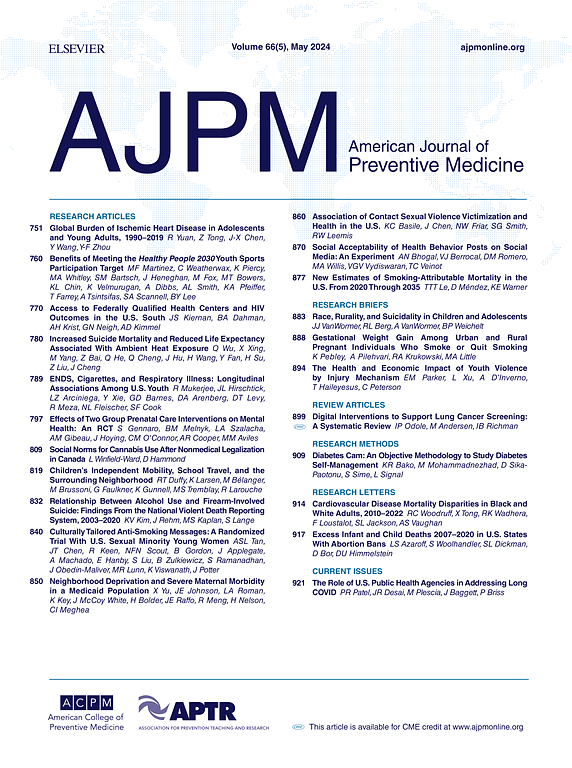中老年人肌肉质量低的体育锻炼悖论。
IF 4.3
2区 医学
Q1 MEDICINE, GENERAL & INTERNAL
引用次数: 0
摘要
导言:体力活动(PA)作为一种治疗与年龄有关的肌肉质量下降的方法已被广泛接受。然而,目前还不清楚是否所有的体力活动都有利于肌肉质量的保持。本研究调查了低肌肉质量与特定领域体育锻炼(包括业余时间和职业性中强度体育锻炼(MVPA))之间的关系:这项研究纳入了 27357 名中老年人(≥40 岁),从 2014 年至 2022 年收集了他们的数据,并于 2024 年对这些数据进行了分析。低肌肉质量的定义是肌肉质量指数比9426名年轻人(20-39岁)的性别平均值低两个标准差。休闲和职业 MVPA 采用全球体力活动调查问卷进行评估,分为 0 分钟/周、1-149 分钟/周和≥150 分钟/周。逻辑回归分析主要针对所有参与者,并根据性别、年龄、久坐时间和转移时间进行了分层分析:结果:就闲暇时间 MVPA 而言,与没有进行 MVPA 的参与者相比,每周 1-149 分钟和≥150 分钟的参与者出现低肌肉质量的几率明显较低,OR 值分别为 0.795(95% CI:0.691, 0.914)和 0.740(95% CI:0.649, 0.843)(p结论:休闲时间的 MVPA 与低肌肉质量成反比,而职业 MVPA 与低肌肉质量没有关系,这突显了足够强度的动态运动和休整时间对保持肌肉质量的重要性。本文章由计算机程序翻译,如有差异,请以英文原文为准。
The Physical Activity Paradox in Low Muscle Mass in Middle-Aged and Older Adults
Introduction
Physical activity is widely accepted as a therapeutic approach to age-related muscle mass loss. However, it is unclear whether all physical activity domains benefit muscle mass maintenance. This study investigated the association between low muscle mass and domain-specific physical activity, including leisure-time and occupational moderate-to-vigorous physical activity (MVPA).
Methods
This study included 27,357 middle-aged and older individuals (≥40 years) whose data were collected from 2014 to 2022 and analyzed in 2024. Low muscle mass was defined as a muscle mass index 2 SDs below the sex-specific average of 9,426 young individuals (aged 20–39 years). Leisure-time and occupational MVPA were assessed using the Global Physical Activity Questionnaire and categorized as 0 min/wk, 1–149 min/wk, and ≥150 min/wk. Logistic regression analysis focused on all participants, and additional analyses stratified by sex, age, sedentary time, and transfer time were performed.
Results
For leisure-time MVPA, participants with 1–149 min/wk and ≥150 min/wk had significantly lower odds of low muscle mass compared to those with no MVPA, with ORs of 0.795 (95% CI=0.691, 0.914) and 0.740 (95% CI=0.649, 0.843), respectively (p<0.01 for both). No significant association was found between occupational MVPA and low muscle mass. These findings were consistent across different strata of sex, age, sedentary time, and transfer time.
Conclusions
Leisure-time MVPA is inversely associated with low muscle mass, whereas occupational MVPA shows no association, highlighting the importance of dynamic movements of sufficient intensity and recuperation time in maintaining muscle mass.
求助全文
通过发布文献求助,成功后即可免费获取论文全文。
去求助
来源期刊

American Journal of Preventive Medicine
医学-公共卫生、环境卫生与职业卫生
CiteScore
8.60
自引率
1.80%
发文量
395
审稿时长
32 days
期刊介绍:
The American Journal of Preventive Medicine is the official journal of the American College of Preventive Medicine and the Association for Prevention Teaching and Research. It publishes articles in the areas of prevention research, teaching, practice and policy. Original research is published on interventions aimed at the prevention of chronic and acute disease and the promotion of individual and community health.
Of particular emphasis are papers that address the primary and secondary prevention of important clinical, behavioral and public health issues such as injury and violence, infectious disease, women''s health, smoking, sedentary behaviors and physical activity, nutrition, diabetes, obesity, and substance use disorders. Papers also address educational initiatives aimed at improving the ability of health professionals to provide effective clinical prevention and public health services. Papers on health services research pertinent to prevention and public health are also published. The journal also publishes official policy statements from the two co-sponsoring organizations, review articles, media reviews, and editorials. Finally, the journal periodically publishes supplements and special theme issues devoted to areas of current interest to the prevention community.
 求助内容:
求助内容: 应助结果提醒方式:
应助结果提醒方式:


